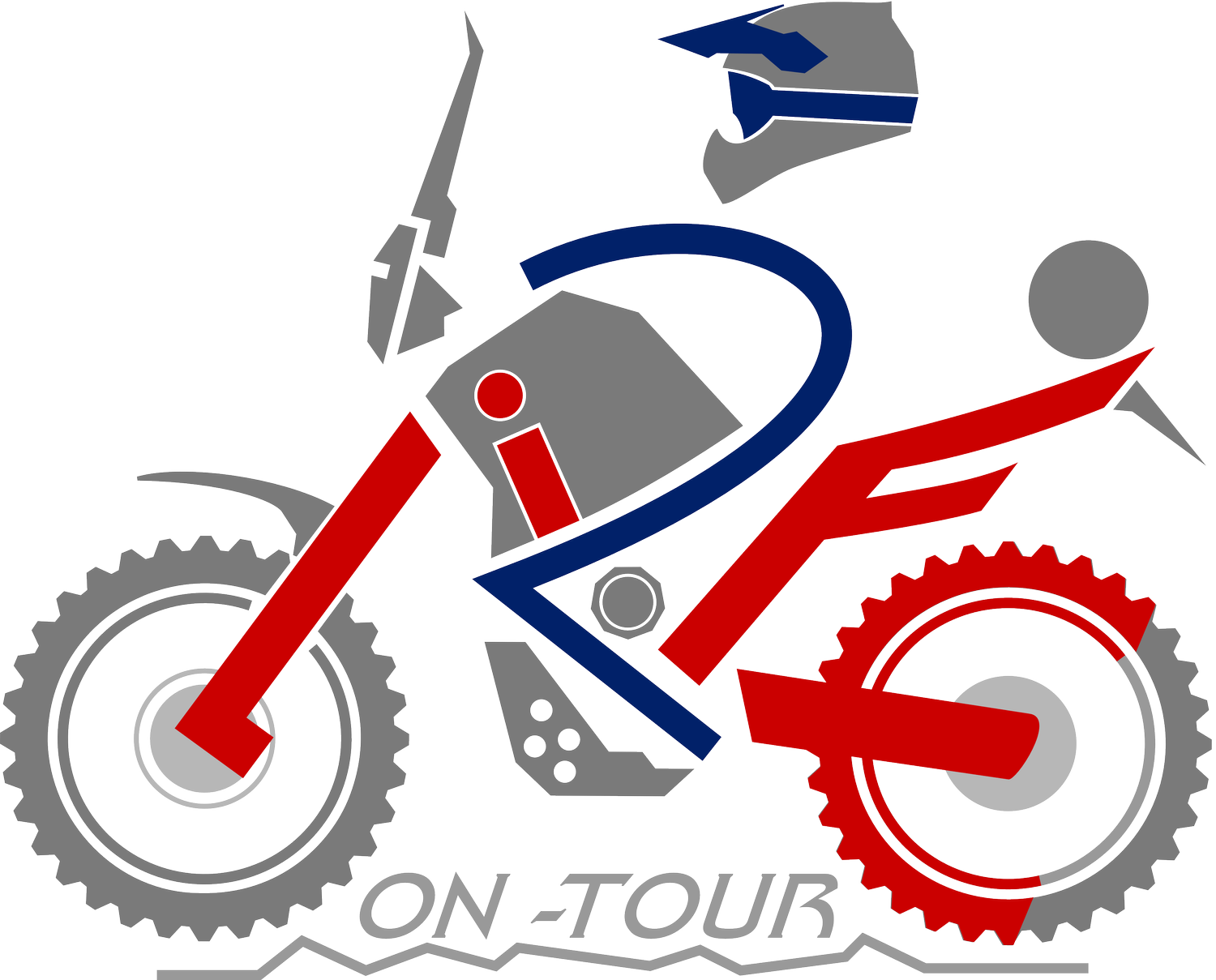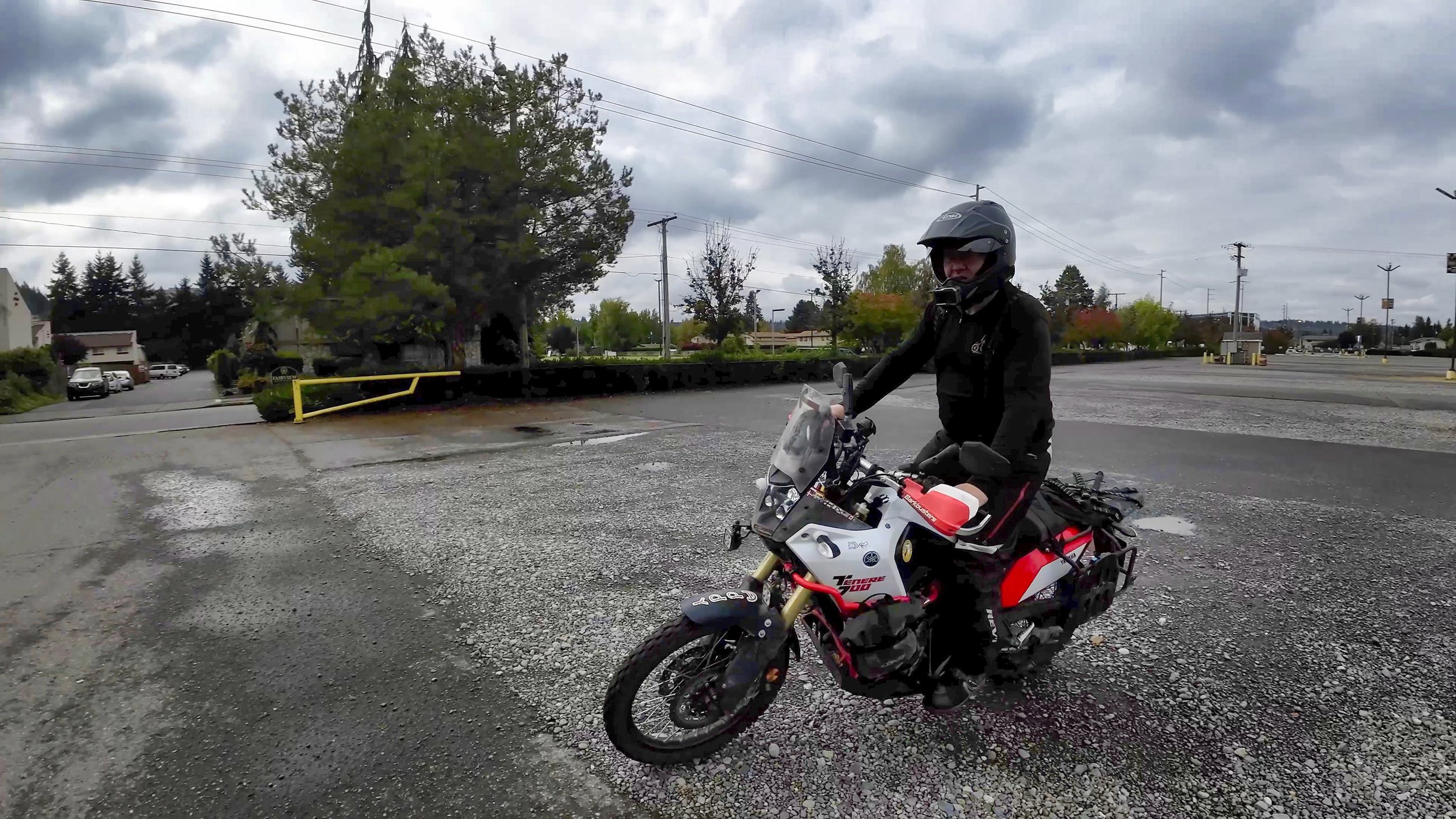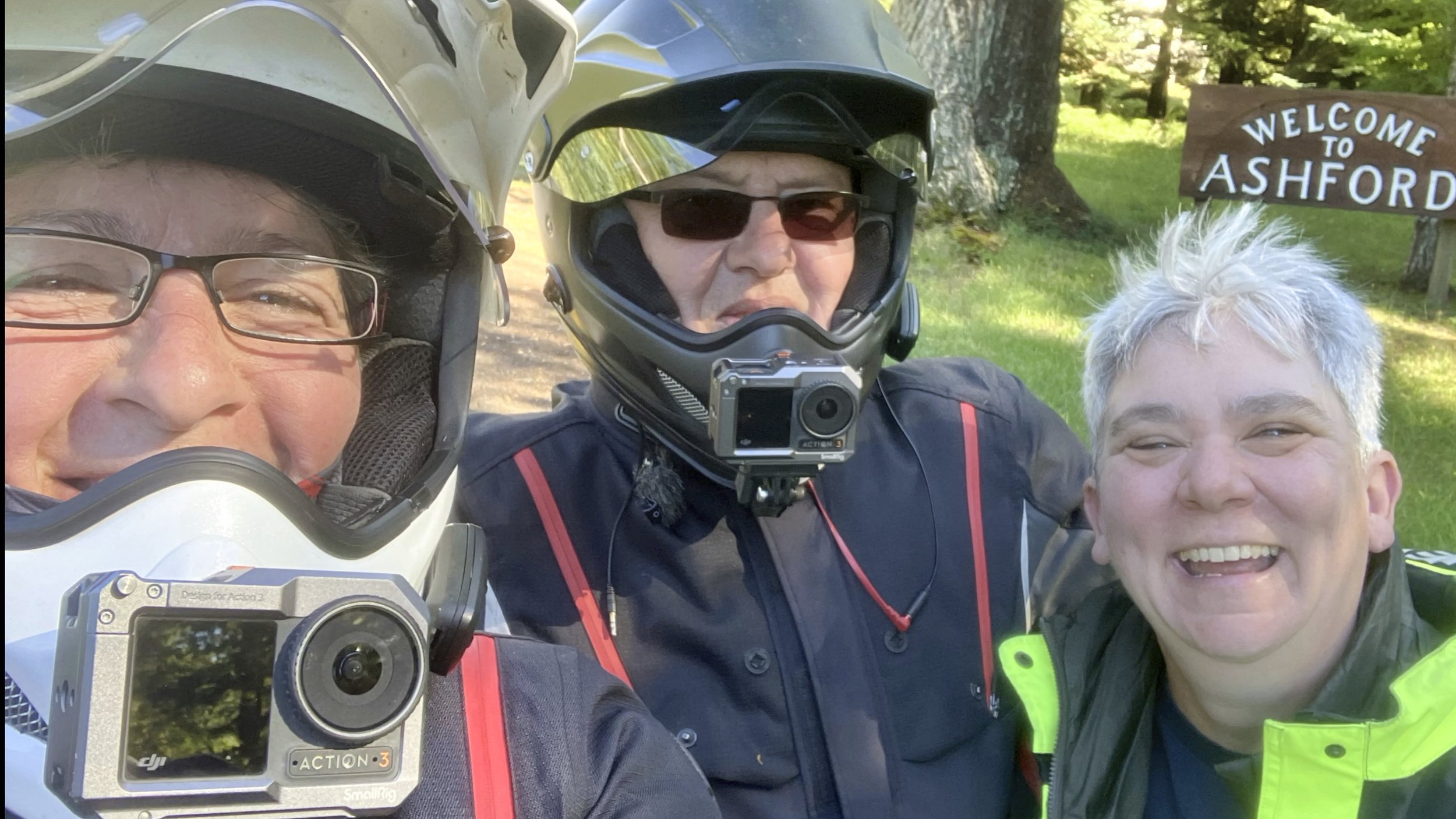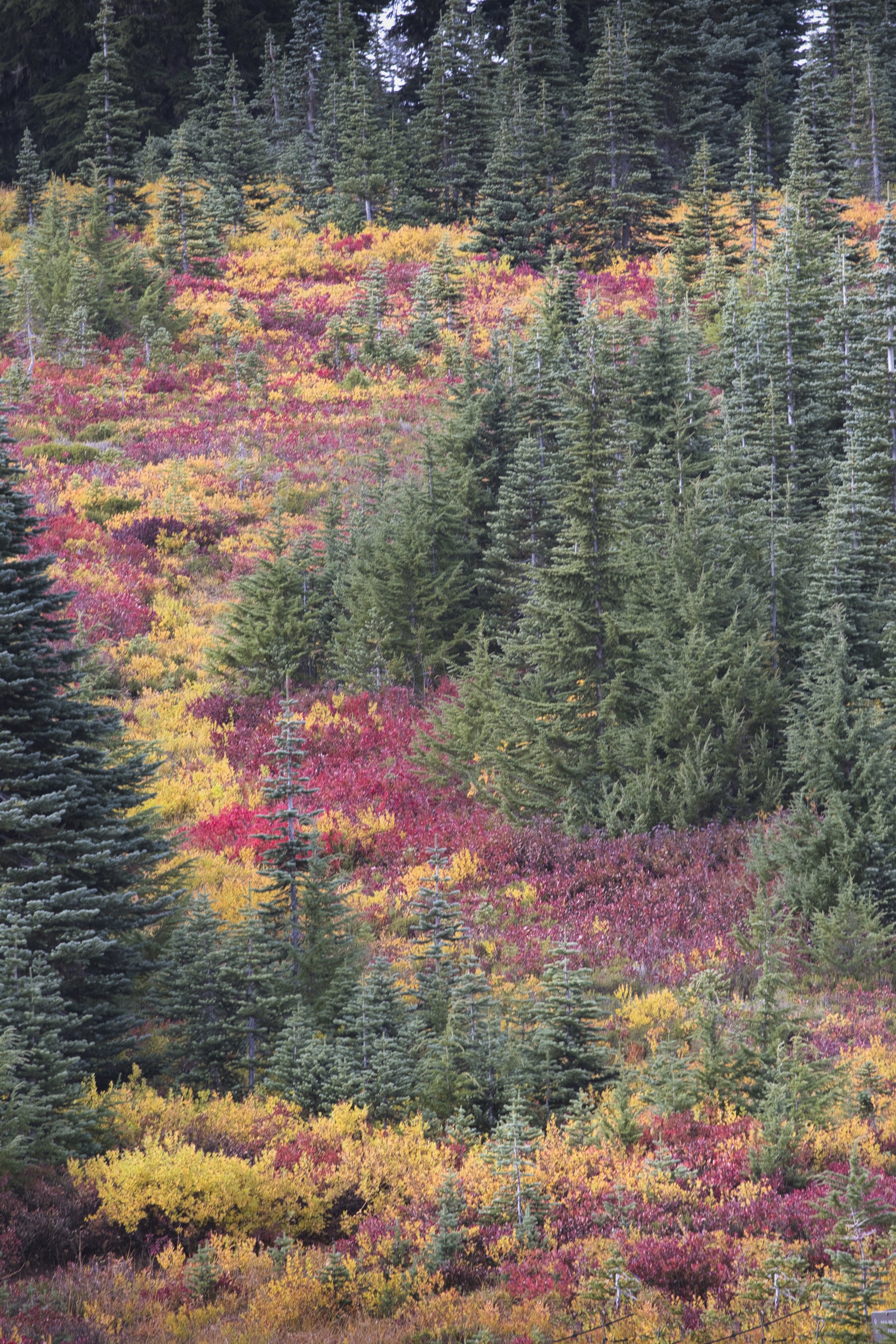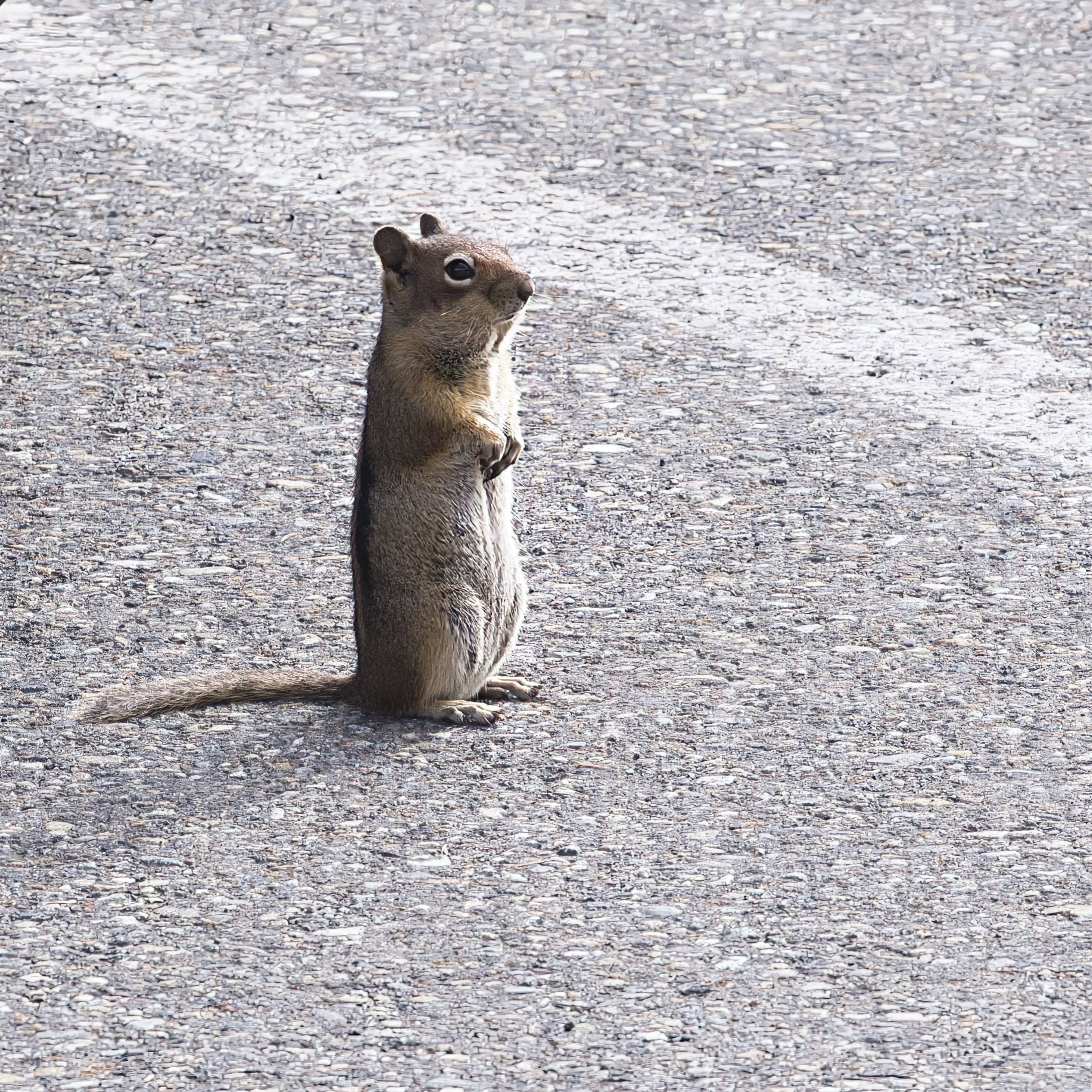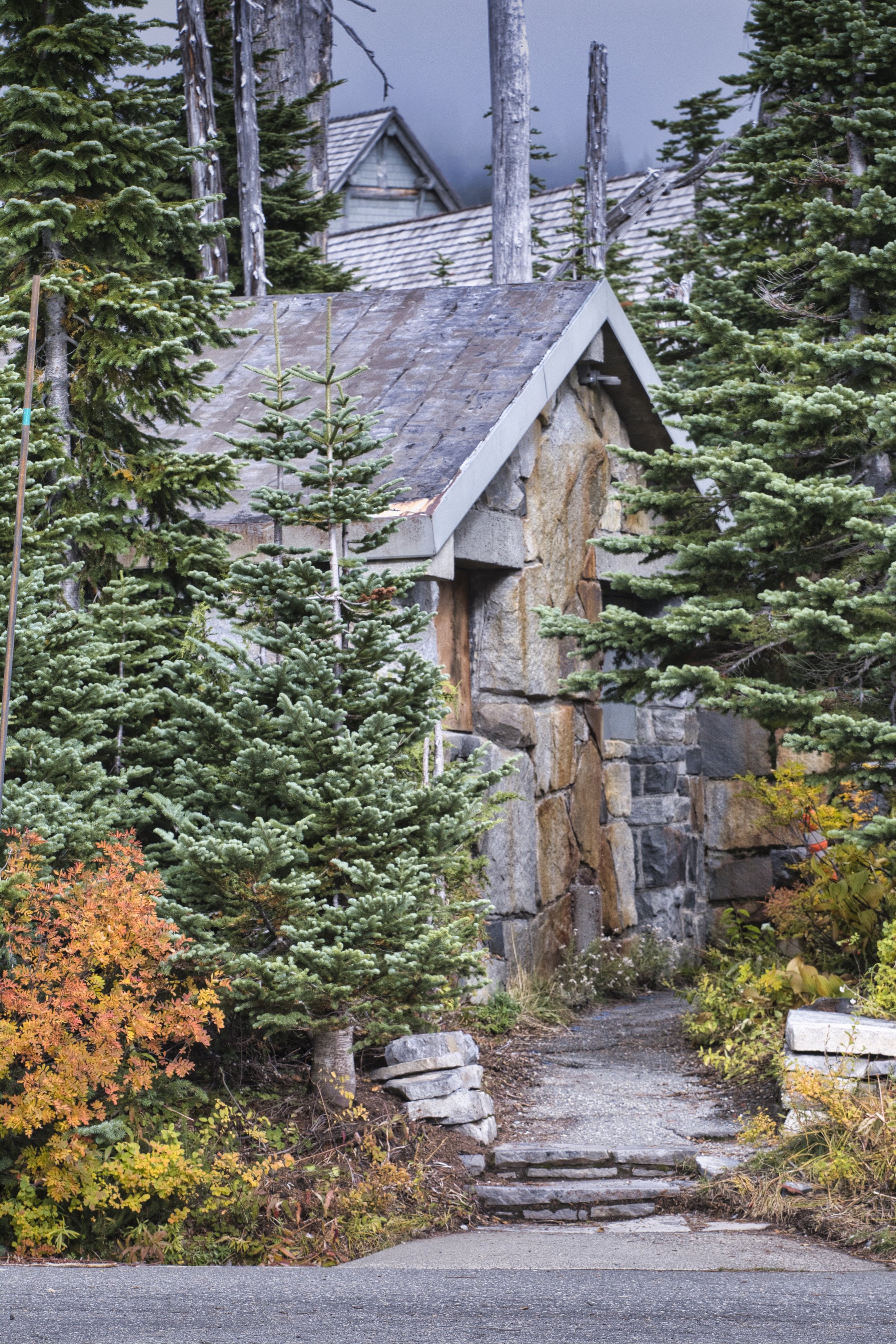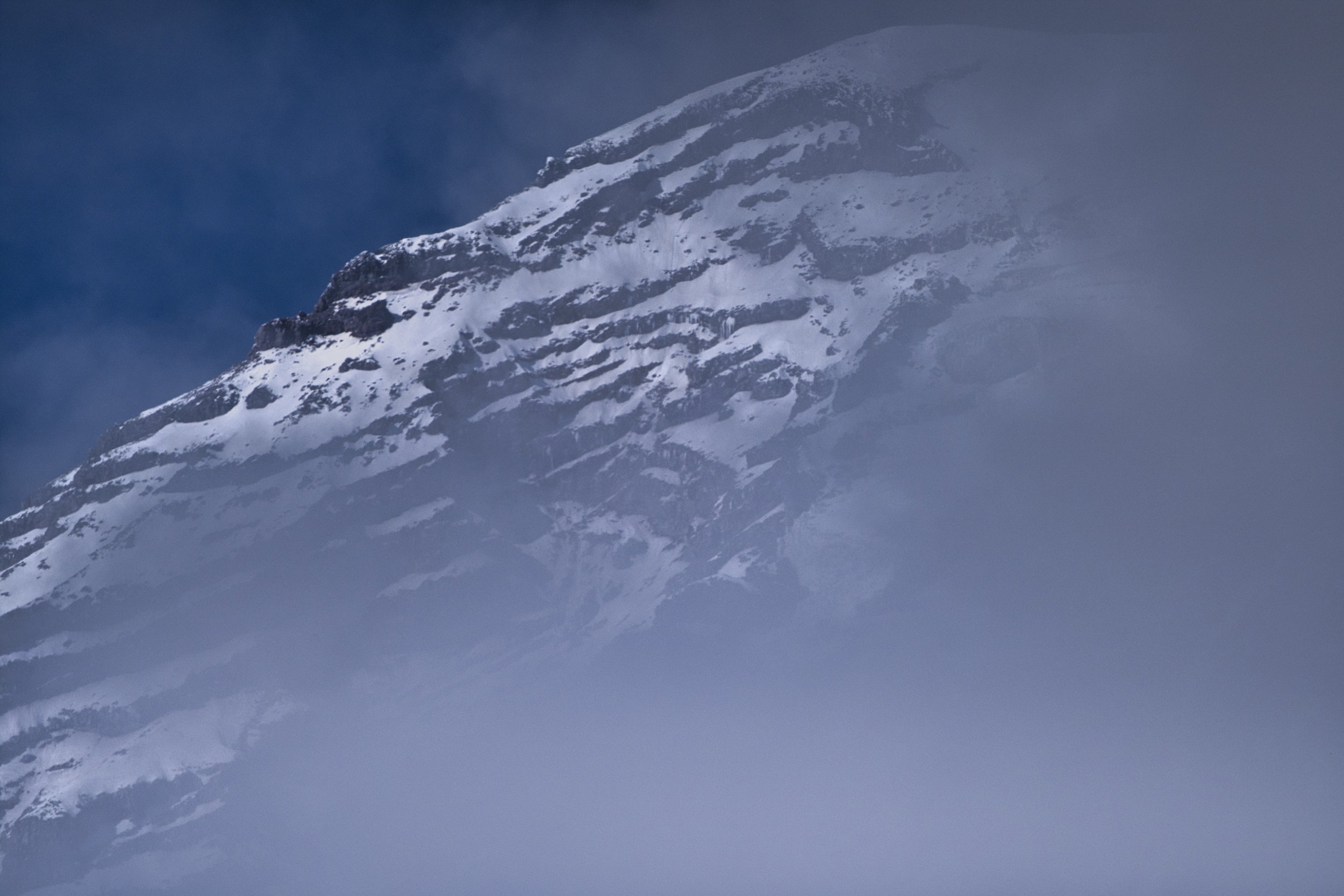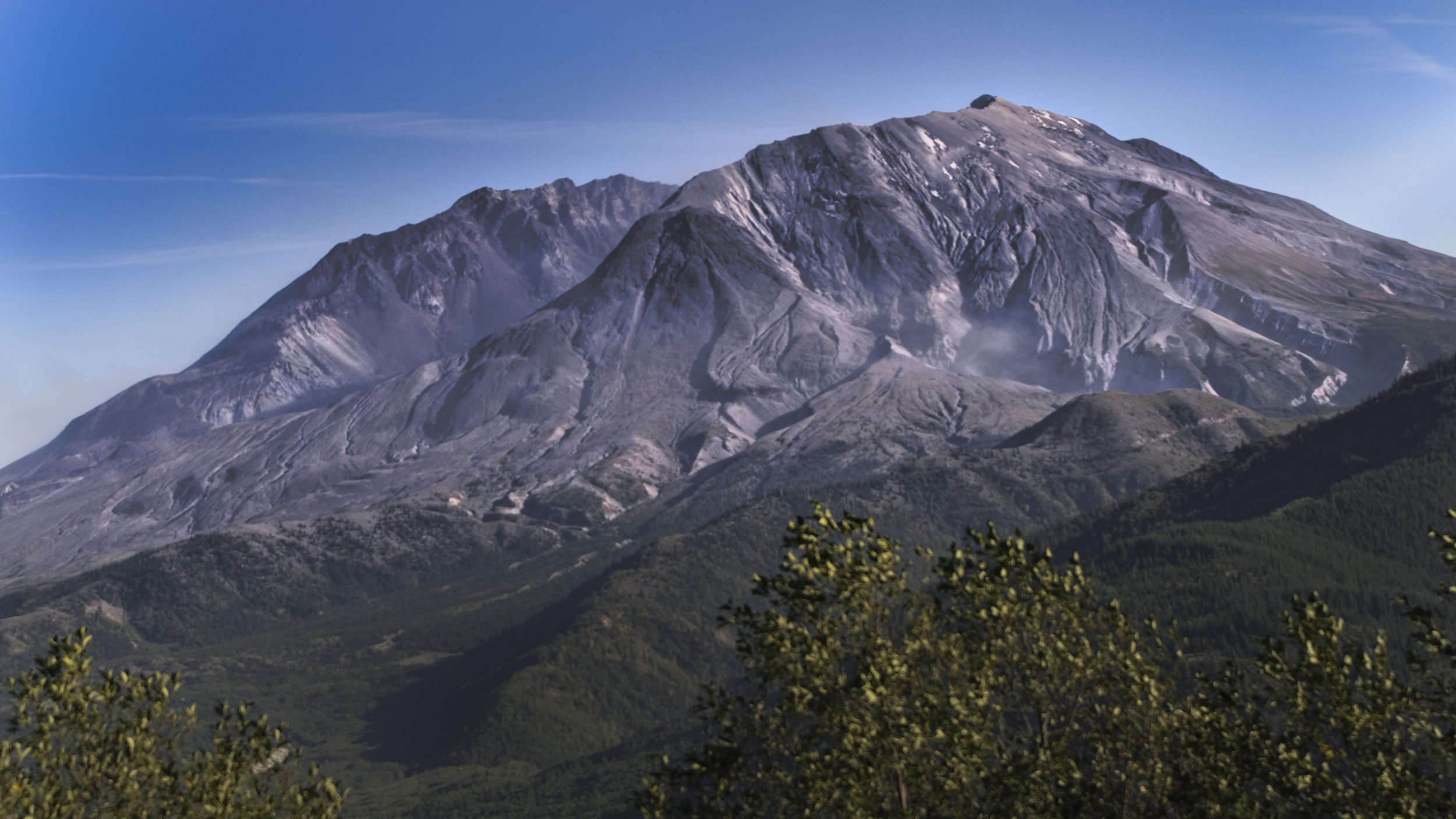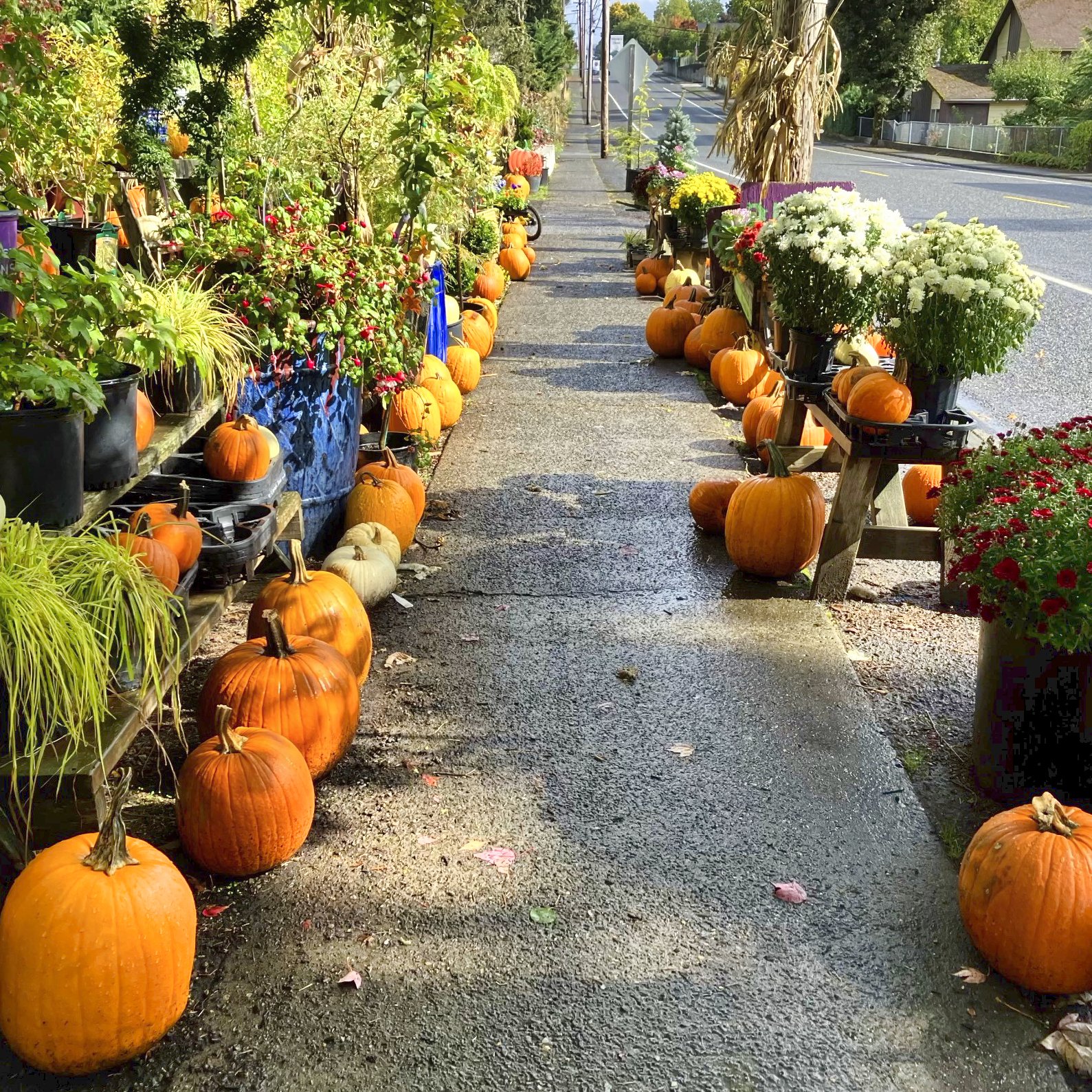Until we meet again.
I have been trying to start this blog for sometime and it is defeating me. Whatever I say will not do justice to the hospitality of Kerry & Katie. But here goes…
The following morning and our first full day in the lower States, we grabbed a few bits of fruit and muffins from the breakfast room, packed the bikes and bade farewell to a really nice place to stay. The weather was not forecast to be great and dark, grey clouds accompanied the start of our journey around the edge of the Olympic National Park.
Once off the main route from Port Angeles to Seattle, the traffic lightened, the road narrowed and the natural world enveloped us in a moist, misty marvel of mountain views, before diving in to marshy creek estuaries with scents of salty seaweed and pine fuelled fires, as locals fight off the foretelling of winter days to come.
At one such estuary, we pulled in to a car park beside an oyster eatery, virtually deserted today but with evidence of busy months just past; the crunch of broken shells beneath our tyres, demonstrating the history of the oyster beds aligned in the tidal waters. As we ate our ill-gotten gains from the breakfast buffet, we watched an eagle lazily take wing from a distant tree whilst the remainder re-asserted the hierarchy from bare branch to branch; the tide continuing its slow retreat from the naked roots but with no sun to dry them out. A beautiful place to restore our energy before pressing on.
The day closed in as we neared the Interstate 5 and the traffic to rival that of the M25; each driver determined to get to their destination without delay. Lorries are not speed-governed as they are in the UK and Europe, and being overtaken whilst doing 65mph by a big old Kenilworth is not the most pleasant of experiences. Throw in the ever-increasing rain and spray, we were struggling to see ahead, whilst keeping half-an-eye behind and full readiness for the wind turbulence of an overtaking lorry returning to the inside lane. When in torrential rain and road-spray, it is impossible to remain dry and today was no different. Pinlocks misted as water seeped in and sapped the warmth from our hands, face and bodies.
Now, before I go on, I must explain a little about Kerry and Katie: When we purchased our T7’s in 2020 and were forced in to Covid lockdown, we spent our time buying kit and equipping the bikes for the journey we never believed we would actually do. One such essential and paramount kit was the Mosko Moto luggage system and, just as we had for many other pieces of kit, we did an un-box and install YouTube video. At this time, Kerry was interested in the Mosko kit and stumbled across our channel. Hearing of our desire to travel the world, Kerry subscribed and left comments on a number of videos that should we find ourselves in the Washington State, we must reach out with any problems, requests etc.,
So…. coming through Canada, we reached out and asked if we could stay a night, which then extended to “can you get some oil, filters and air filter for us?”, with the immediate answer being a big fat yes!
Like drowned rats, we knocked on the door and were immediately greeted by 2 mad terriers and 2 full-faced grins. It’s a strange part of travelling, that you meet people you feel you already know, but only for the first time. We were immediately made welcome and given time and space to dry out and feel vaguely human - the first impressions we give others must be disappointing as helmet hair, filthy faces, jackets and boots are our norm, not to mention varying stages of whiffiness..
Just a few days before our visit, Katie had had hip surgery and was getting around with a zimmer frame and cut tennis balls to aid movement and protect the floor. That night was the first night Katie had been out of the house since surgery, as we went in search of a restaurant. I immediately adopted the role of support, getting the frame to and from the car, complete with tennis balls. As we returned to the car, Katie had to avoid a puddle in the carpark and me, not applying my adult-filter, said “mind you don’t get your balls wet”. Thankfully met with laughter as I apologised for my childish attempt at humour - they got the measure of me pretty quickly!
The next day was oil and filter change day. Kerry had all the parts ready and after a short ride around the fairground car park to warm the oil, it was time to get on with it. I’m always anxious about starting a job as all the ‘what-ifs’ flood in to my head and cause a 10 minute job to become a few hours. This was one of the jobs where the ‘what-ifs’ proved ridiculous as the job proceeded well - old out, new in, including a very easy job to replace the air filter and remove all the Dalton Highway dust!
Warming up the bikes
Fat bloke on a bike
Out with the old
Oil fill made easy!
Dust!
Service done, we were invited to stay another night and Kerry would show us Mt Rainier the following day. The hope was to complete a circle of the mountain, but the road to the North and East remained closed, so a “there and back” route it was to be. Isi and me followed Kerry out of the city, with the three of us treating the Stop junctions as one vehicle - When Kerry went, we all went. It did make me wonder how a funeral procession of coffin and mourners negotiated the Stop junctions, as the system of give way all ways, would lead to the procession being split up very quickly.
City gave way to suburbs, that gave way to fields and again to forest, lakes and isolated villages. One beautiful lake was surrounded on all banks by houses, slipways and private moorings. A Fishermans paradise if ever there was one.
We saw signs for Ashford and stopped at the city-limits to have our photo taken - nothing like the Ashford we had left at home as this was quiet, clean, green and just a small community.
So many smiles at Ashford
Ashford, but not as we know it.
As we reached the National Parks access booth, we were required to pay $25 per bike or we could by an Interagency Annual pass that would allow access to multiple National Parks. For $80, this included 2 bikes and riders and was the obvious choice as we knew we had many other parks to visit on our way South. $30 deficit for Mt Rainier but would prove a significant money saver over the next few months.
Once in the National Park, the road became narrower and twistier as it climbed through forests of sky-scraping pines with views dropping violently to valley ravines and sky-rocketing up sheer cliff faces enough to make your neck ache, before reaching in to the next hairpin and ever upwards. The summit of Mt Rainier would seldom appear from the cloak of fluffy cloud, revealing the snow smattered, rough, craggy rock that continued to tower above us. The trees had given way to stunted pines and ground cover best suited to the limited oxygen and soil beneath their roots. Ground squirrels would supplement their natural diet with scraps left by the numerous visitors that would take shelter in the visitors centre, escaping the cool mountain breezes that quickly removed the blanket of warmth from their cars.
Indeed, paradise…
Autumn colour
Feed me!
Built for the white stuff
Mt Rainier as clouds part
Suddenly, there she was!
Mist
We followed them in to the centre, not to peruse the gift shop, but to learn of the geology and geography of the sleeping giant that is well overdue an awakening. Kerry and Katie’s house is in the valley where the volcanic outflow is most likely to travel and they have already agreed that if they receive the official warning, they will grab deckchairs, a drink and enjoy their last moments marvelling at the power of nature. A glamorous outlook on their last moments but one we would share - if it’s going to happen, enjoy the moment with those you love!
We were due to leave the next morning but a worrying health development resulted in us asking if we could stay yet another night. Whilst Isi has passed her 5 year treatment for breast cancer with no immediate concerns, the thought of a return is as much a part of life as breathing. It is hard not to be worried about abnormal happenings and that morning was one such time. Having been unsuccessful to secure an early smear test in the UK, the mornings development led to alarm and concern. Being the USA, we couldn’t just walk in to a hospital and ask to be treated, as it costs money and the health system can rack up considerable sums very quickly as most Americans have insurance to cover the cost. A different way of funding to the UK NHS but neither of which were available to us. Talking to Kerry, she advised of a charity called Planned Parenthood, who would provide health services for those that could not afford insurance, in the belief that everyone deserved access to basic health services.
A few phonecalls later and Kerry was driving Isi an hour in to Seattle, whilst I spent my time shopping and preparing an evening meal for the 4 of us. I had to do something and tackling a new kitchen to prepare a feast was distraction enough. When they returned, it was agreed we would finally leave the next morning and crack on with the trip. Test complete, we just had to wait for the results and try and put it to the back of our minds until then. (We have since had the results and all was well).
The next morning came and all excuses to stay longer had been exhausted - it really was time to leave. Bikes packed and fighting back tears, we hugged, promised to meet again and waved a heartfelt goodbye. In the space of a few days, a strong bond had formed that time and distance would not dull.
The ride out found us heading South and West, cursing the traffic and numerous lights before the road left the metropolis behind. Not the most scenic of routes but in the space of a few hours, we had passed through both Rochester and Aberdeen before reaching our campsite on the Pacific Coast and Isi’s first swim in a new ocean with waves rolling in from Japan or other such far-flung places. Too cold to linger, despite the pull of the ocean to remain and gaze, lost in the enormity of the water lapping at our feet, so back over the sand dunes and to the not-so-secluded or quiet campsite. The occupants of one RV a few pitches along, would frequently and repeatedly break out in slanging matches resulting in doors being slammed and truck alarms screaming aloud, throughout the night and in to the next day.
The Pacific is cold!
That surface is horrible! The bridge in to Aberdeen.
We were happy to leave and continue South along the coast road hugging the tributaries of the estuaries, then climbing and descending through natural landscapes of salt marsh, deciduous forests and scrubland before reaching Long Island. Here, we made a diversion in to Cape Disappointment State Park, named after Captain John Meares who failed to cross the river bar in 1788. Whilst the task was completed some years later, the name has stuck. When we stopped at one of the numerous viewpoints, a man came over to us and just said “do you have a YT channel?” We said yes and pointed toward the QR code on the bikes. He snapped the QR code, jumped in his truck and drove off without another word. Bizarre, but we’ll take views however they appear!
The chase is on!
Steeper than it looks.
Then it was off to the reason we had spent the last 2 days heading South and West. The Astoria-Megler bridge spans the Columbia River between Washington and Oregon and is the longest cantilever-through-truss bridge in North America. The 4 mile long bridge is close to the water on the Northern side, as the waters are shallow. However, the bridge rises to nearly 200 feet with a steep ramp mid-river and a 360 degree spiral to the far bank, to allow shipping to pass in the deeper, Southern side of the river. Photos and videos will not accurately convey just how steep the ramp is and riding it was an experience to remember.
Vertical lift bridge
From the top of the bridge, we saw another in the distance and decided to ride that too. The New Youngs Bay Bridge is not as grand as the previous but has a vertical lift section that allows for boat traffic to access the bay, stopping the traffic to do so. The Pacific Ocean was hidden from view by the sea mist that was rolling in, as we turned around and headed back to Washington via the same two bridges.
I really wanted to stop!
As we gained solid ground in Washington, we saw signs for road closure and diversions. Whilst initially ignoring the signs, we noticed a distinct lack of traffic and came to the conclusion that the road was indeed closed somewhere ahead. A quick stop, a Google and we found the only way out was to backtrack the roads we had taken for most of the day; a diversion of 30 miles. Finally back on track, we started looking for a place to stay with very few places available. We stopped at a campsite near Deep River with eye-wateringly high prices and whilst the portaloo was included, it was extra for a lean-to shower. Thankfully, the place was relatively empty so the queue for the portaloo was never too long. Not one of the greatest sites we have stayed at and not one we would ever recommend.
The following day was riding along very similar roads to the day before but without the ocean or rivers for company. Our destination was Mount St Helens and one of the first International news stories that piqued my interest. The eruption in May 1980 remains the deadliest and most economically destructive, natural event in US history. Fifty-seven people were killed; 200 homes, 47 bridges, 15 miles of railways, and 185 miles (298 km) of highway were destroyed. A massive debris avalanche, triggered by a 5.1 earthquake, caused a sideway eruption that reduced the elevation of the mountain's summit from 9,677 ft to 8,363 ft, leaving a 1 mile wide horseshoe-shaped crater. The volcano remained active until 2008 and geologists state the angle, size and location of the lava dome means more power will be required when it next erupts, making it the most dangerous in North America.
Is it smoke or cloud?
Mt St Helens.
We agreed it must be cloud
Water will win every time.
Before entering the National Park, we stopped at a local supermarket to replenish supplies and, as usual, I stayed with the bikes while Isi had the arduous task of going inside. As is becoming the norm, the bikes and licence plates attract attention and it wasn’t long before I was chatting to a local who said his parents and grandparents lived through the eruption, the years of cleanup after and are still in the area. It is always amazing to add local knowledge to an area, especially one that has been with me for most of my life.
After a short stop at the Visitor Centre to eat lunch and chat to the tourists from a cruise ship docked near Portland, we rode as far as we could, through newly planted forests of pine, over numerous new bridges and along the replaced tarmac. There was evidence everywhere of the debris flow that had forged a new landscape, rivers that had newly cut a path down the valley to maintain their flow to the sea, but the most striking was the pine forests.
The largest of the new bridges
Following the eruption, the commercial logging companies were quick to salvage as much timber as they could, to clear access to the area and to recoup some of their financial losses. These same companies were quick to replant to conserve their business interests and return the jobs and industries to the area. However, in 1982, an area encompassing Mount St Helens, was declared a National Volcanic Monument and it was declared that the area would remain for nature to recover in its own time. 40 years later, this line can still be seen between the commercial planting and the natural re-wilding, with nature providing a more diverse tapestry of species and colours. We are not against the commercial planting as this provides much needed employment and is sympathetically done, but it is obvious nature is better at providing an environment for nature.
On the way back down the mountain, we looked for a pitch for the night; passing closed sites before finding a site occupied by construction workers employed in the repair to the roads and the logging industry. It really was a nice site with hot showers, at a fraction of the price of the previous night. Other than the occasional truck engine breaking, the night was peaceful and our first night to play Crib, with Isi winning the night. The following morning, we broke camp in the cold dry air, listening to the birds in the trees and the wind blowing in the top of the tall pines we were camped beneath.
Carl was losing…
New reading glasses!
As with all our rides, we try to avoid the Interstates and Freeways as much as possible. The Old Pacific Highway ran alongside the new I-5, meandering through small towns and sprawling housing plots and developments but then the rain started and the temperature dropped. We persevered with the, at times, very twisty, steep and slippery road, with me very much aware of the rear tyre reviews ‘not so great in the cold and the wet’ and slowing up both Isi and the following traffic. Both our visors started to fog up despite the best efforts on the Pinlock, so it was time to find a warm, dry haven to look at possibilities.
Watching the car park drains struggle to cope with the run-off and people joking that it’s not about if it will rain, rather how heavy it will rain, we discounted another camp for the night and found a last minute deal on a well known booking site and a place to aim for. With a 1.5hr ride ahead, we joined the I5 and the crazy rain, spray and traffic. As we crossed back in to Oregon and turned East, our very limited visibility provided glimpses of stunning mountains, veiled in cloud and mist.
To get back to Washington, we had to cross back over the Columbia River at the Bridge of The Gods; a steel truss bridge constructed in 1926 and modified in 1938 due to raised river levels following the construction of the Bonneville Dam. A toll bridge that remains a vital economic and social link for the surrounding and somewhat remote areas in Washington and Oregon.
Given the weather, we were in no mood to sight-see and even less impressed to have to pay a $4 toll (for both) and, I have to say, I did discuss the option of motorcycles being free as I fought with wet gloves, rain covers and cold fingers, whilst watching the queue of traffic build up behind us. We were not moving off until completely ready as there were no stopping points until the other side. On any other day, the views and bridge construction would have been a delight but, today, we just wanted to get on.
The smaller road was a relief after the Interstates and we eventually rolled in to a very wet Carson Hot Springs hotel and the promise of spring waters to warm the bones and relieve the bad backs we were both suffering from.
In 1876, Isadore St. Martin was on a hunting expedition, when he discovered the hot springs bubbling up through the rocks of a riverbed. When he slipped his hand into the water, he was shocked to find that the springs were comfortable to the touch. St. Martin marked the spot to file an Indian Homestead claim on the site and headed home to his wife, who suffered from neuralgia. St. Martin told her about the springs, and they excitedly discussed the potential healing capabilities that lay within the waters. Eventually, they obtained the legal rights to the springs and, to their joy, his wife experienced immense relief from her neuralgia. Word spread of the powers of the waters, so in 1897 St. Martin began constructing a safe place for those in need of "taking the waters.”
The above is taken from the resorts home page and whilst historically correct, I take umbrage over the process of making a legal claim and then owning the area. The indigenous tribes have owned and used the land for many centuries before but, just as we have seen numerous times, the European settlers claimed the land for themselves with little regard for the true custodians.
Hotel St Martin, now called Carson Hot Springs to improve search engine hits
The original hotel still remains but only the ground floor can be used and you have to wonder how long that will remain. Speaking to the receptionists, it seems there are plans to renovate the original building but the cynic in me says this will be delayed until there is no choice but to build new. Over time, more buildings have been added to now create a resort with the golf course included in the attractions. The older bath house still exists but the prices were too much for us, so we settled on the mineral pools, that were more akin to a public swimming pool, with all the health and safety requirements of added chlorine etc.,
Can you guess the season?
We woke the next morning and the rain continued to pour, so one night became two (that also became three) and we planned a walk to the town. We needed food supplies and stamps so off we trudged in the rain, enjoying the views of fields, mountains, gardens and shops, venturing in to a coffee shop for a fantastic soup and coffee. Inside were more children than adults, ranging from 4 to 15 years old. Without exception, all were extremely well behaved, engaged in conversations and activities with each other and the adults from the community. The 4 year old was wiping down tables with her dress, until provided with a cloth more suited for the task. She was very sweet.
Rain, rain, go away…
That evening, we ventured to the seating area at reception, where there was a real kettle (a rarity in North America) and choices of teas and hot chocolate. Chatting to one of the receptionists, he provided a potted history of the place and invited us ‘backstage’ to what was once the breakfast room and restaurant. Against the wall was an old piano in very dire need of tuning but still playable and, after some persuasion, Isi brought music to an old place full of many stories of times past. It was so nice to spend time listening to Isi play whilst I perused the wall paintings of local scenes and the people that led to this moment.
The sign of all professional pianists - Crocs.
The morning of our fourth day was dry and remained so as we packed the bikes and headed out. As I pulled out of the first junction to turn right, the air turned blue with numerous expletives shouted across the airwaves as Isi fought to keep the bike upright having stalled the engine…
